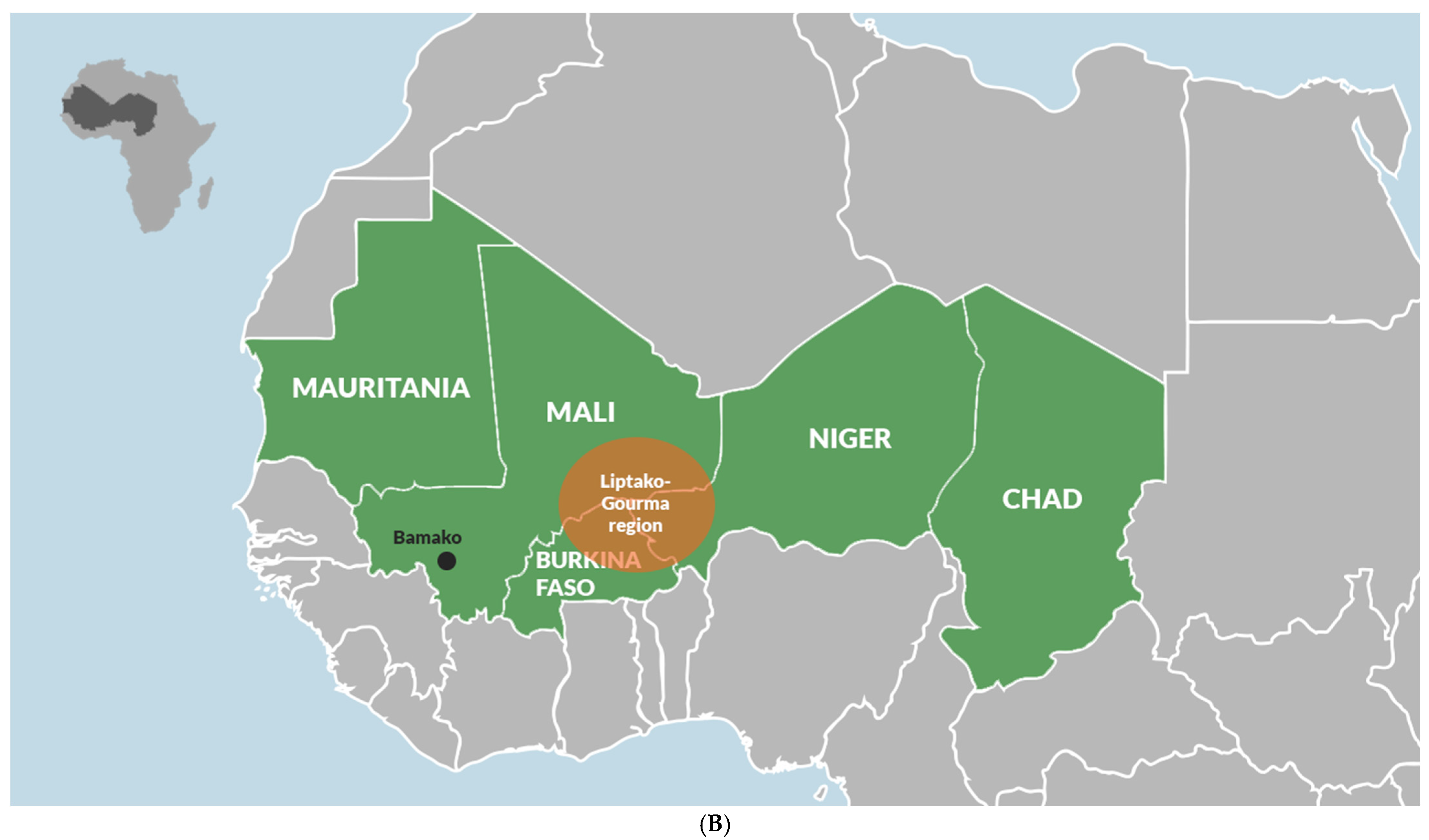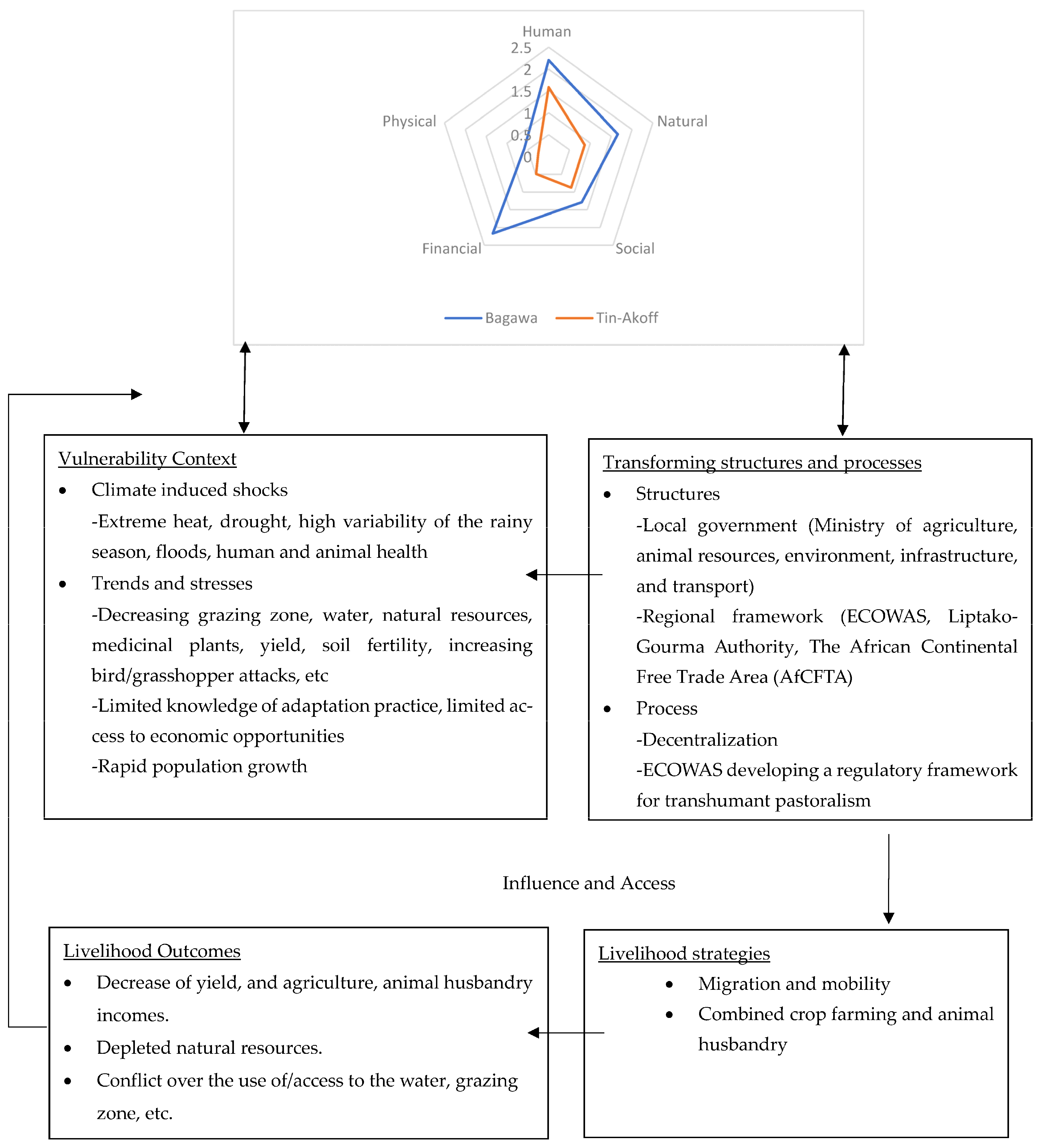Application of Sustainable Livelihood Approach (SLA) to Address Climate-Induced Risks through the Lens of Africa Borderland
Abstract
1. Introduction
Characteristics of Livelihood in Liptako-Gourma Region in the Sahel
2. Materials and Methods
2.1. Data Collection
2.2. Data Analysis
3. Results
3.1. Study Area
3.2. Climate Perception in the Study Area
3.3. Livelihood Assets of Villages of Bagawa and Tin-Akoff
4. Discussion
5. Conclusions
Author Contributions
Funding
Institutional Review Board Statement
Informed Consent Statement
Data Availability Statement
Acknowledgments
Conflicts of Interest
References
- OXFAM Burkina Faso: Second Biggest Spike in Displacement Since Crisis Began|Oxfam in West Africa. Available online: https://www.oxfam.org/en/press-releases/burkina-faso-second-biggest-spike-displacement-crisis-began (accessed on 17 December 2022).
- OCHA Burkina Faso: Almost 2 Million People Displaced Amid Worst Food Crisis in a Decade—Burkina Faso|ReliefWeb. Available online: https://westafrica.oxfam.org/en/latest/press-release/burkina-faso-almost-2-million-people-displaced-amid-worst-food-crisis-decade (accessed on 17 December 2022).
- United Nations Document—Joint Statement Sahel—Strengthening of the Protection of Civilian Populations in the Sahel (unhcr.org). Available online: https://data-uat.unhcr.org/en/documents/details/77070 (accessed on 17 December 2022).
- Sawo, A. The Chronology of Military Coup d’etats and Regimes in Burkina Faso: 1980–2015. Turk. Yearb. Int. Relat. 2017, 48, 1–18. Available online: https://dergipark.org.tr/tr/download/article-file/844858 (accessed on 17 December 2022).
- Lyammouri, R. Mobility and conflict in Liptako-Gourma|Global Initiative. 1 February 2021. Available online: https://globalinitiative.net/analysis/liptako-gourma/ (accessed on 17 December 2022).
- Gestion de la migration et des frontieres au Burkina Faso. Available online: https://publications.iom.int/fr/books/gestion-de-la-migration-et-des-frontieres-au-burkina-faso (accessed on 17 December 2022).
- UNDP Africa Borderland Centre. Africa Borderlands Centre: Project Document: UNDP in Africa. February 2021. Available online: https://www.africa.undp.org/content/rba/en/home/library/reports/africa-borderlands-centre---project-document.html (accessed on 17 December 2022).
- William Assanvo, Baba Dakono, Lori-Anne Theroux-Benoni and Ibrahim Maiga, Violent Extremism, Organized Crime and Local Conflicts in Liptako-Gourma, ISS. December 2019, p. 7. Available online: https://issafrica.org/research/west-africa-report/violent-extremism-organised-crime-and-local-conflicts-in-liptako-gourma (accessed on 17 December 2022).
- Doutressoulle, G. L’Élevage en Afrique Occidentale Français; Éditions Larose: Paris, France, 1947. [Google Scholar]
- Baier, S. An Economic History of Central Niger; Oxford University Press: Oxford, UK, 1980. [Google Scholar]
- Smith, A.B. Pastoralism in Africa: Origins and Development Ecology; Ohio University Press: Athens, OH, USA, 1992; Available online: https://brill.com/downloadpdf/book/edcoll/9789004491700/back-3.xml (accessed on 17 December 2022).
- The World Bank Population Growth (Annual %)|Data. Available online: https://data.worldbank.org/indicator/SP.POP.GROW (accessed on 18 December 2022).
- PRB Demographic Challenges of the Sahel|PRB. Available online: https://www.prb.org/resources/demographic-challenges-of-the-sahel/ (accessed on 18 December 2022).
- United Nations. UNISS—RELIEFWEB. Available online: https://reliefweb.int/sites/reliefweb.int/files/resources/UN_UNISS_Report_En.pdf (accessed on 18 December 2022).
- Garraud, S.; Mahamane, L. Evolution des pratiques d’adaptation des communautés agropastorales de la zone de Tillabéry-Nord et de Tahoua au Niger dans un contexte de changements climatiques. Sécheresse 2012, 23, 24–30. [Google Scholar]
- De Bruijn, M.; Van Dijk, H. Drought and coping strategies in Fulbe society in the Haayre (central Mali): A historical perspective. Cah. D’études Afr. 1994, 34, 85–108. Available online: https://www.persee.fr/doc/cea_0008-0055_1994_num_34_133_2041 (accessed on 18 December 2022). [CrossRef]
- Toulmin, C. Herders and Farmers or Farmer-Herders and Herder-Farmers? 1983. Available online: https://vtechworks.lib.vt.edu/handle/10919/66211 (accessed on 18 December 2022).
- Turner, M.; McPeak, J.; Ayantunde, A. The role of livestock mobility in the Livelihood strategies of Rural peoples in SEMI-ARID West Africa. 15 January 2014. Available online: https://link.springer.com/article/10.1007/s10745-013-9636-2 (accessed on 18 December 2022).
- Abroulaye, S.; Issa, S.; Abalo, K.E.; Nouhou, Z. Climate change: A driver of crop farmers-agro pastoralists conflicts in Burkina Faso. Int. J. Appl. Sci. Technol. 2015, 5, 92–140. Available online: http://www.ijastnet.com/journals/Vol_5_No_3_June_2015/10.pdf (accessed on 18 December 2022).
- Brottem, L. Pastoralism and conflict in the Sudano-Sahel: A Review of the Literature. July 2020. Available online: https://csf-sudan.org/library/pastoralism-and-conflict-in-the-sudano-sahel-a-review-of-the-literature-2/ (accessed on 18 December 2022).
- Nkonya, E.; Place, F.; Pender, J.; Mwanjololo, M.; Okhimamhe, A.; Kato, E.; Crespo, S.; Ndjeunga, J.; Traoré, S. Climate Risk Management through Sustainable Land Management in Sub-Saharan Africa. IFPRI Discussion Paper 1126. 2011. Available online: https://link.springer.com/chapter/10.1007/978-3-319-61194-5_19 (accessed on 18 December 2022).
- Daniel, S. AQMI. In L’industrie de l’enlèvement; Fayard: Paris, France, 2012. [Google Scholar]
- Lacher, W. Organized Crime and Conflict in the Sahel-Sahara Region; The Carnegie Papers: Washington, DC, USA, 2012; Available online: https://carnegieendowment.org/2012/09/13/organized-crime-and-conflict-in-sahel-sahara-region-pub-49360 (accessed on 18 December 2022).
- Haavik, V.; Bøås, M.; Iocchi, A. The End of Stability—How Burkina Faso Fell Apart, African Security. 2022, p. 2. Available online: https://www.tandfonline.com/doi/full/10.1080/19392206.2022.2128614 (accessed on 18 December 2022).
- State Controls Just 60 Percent of Burkina Faso: ECOWAS Mediator. Available online: https://www.aljazeera.com/news/2022/6/18/state-controls-only-60-percent-of-burkina-faso-mediator (accessed on 17 December 2022).
- United Nations Security Council Counter-Terrorism Committee Executive Directorate (CTED). Available online: https://www.un.org/sc/ctc/wp-content/uploads/2019/06/ctc_cted_fact_sheet_designed_border_management_december_2018.pdf (accessed on 17 December 2022).
- Gallati, L.; Rodriguez, A.; Wang, Y.; Min, K.; Singeorzan, A. ‘Mali and Burkina Faso: Their bordering tensions’ June 2016. Available online: https://www.academia.edu/32163718/Mali_and_Burkina_Faso_their_bordering_tensions (accessed on 17 December 2022).
- Emmanuel, S. A Review of Past Security Events in the Sahel 1967–2007; OECD: Paris, France, 2010; p. 22. Available online: https://www.oecd.org/swac/publications/47092939.pdf (accessed on 17 December 2022).
- Burkina Faso’s New Transitional Legislature TAKES office. Available online: https://www.africanews.com/2022/11/11/burkina-fasos-new-transitional-legislature-takes-office// (accessed on 17 December 2022).
- Hagberg, S.; Körling, G. Soico-political Turmoil in Mali: The Public Debate Following the Coup d’Etat on 22 March 2012. Afr. Spectr. 2012, 47, 111–125. [Google Scholar] [CrossRef]
- United States Institutes of Peace. Available online: https://www.usip.org/publications/2020/08/five-things-know-about-malis-coup (accessed on 17 December 2022).
- DFID’s Sustainable Livelihoods Approach and its Framework. Available online: http://www.glopp.ch/B7/en/multimedia/B7_1_pdf2.pdf (accessed on 24 December 2022).
- Liptako-Gourma Authority. Available online: https://www.liptakogourma.org/wp-content/uploads/2020/08/Plaquette_dinformation.pdf (accessed on 18 December 2022).
- Le Ministère de l’Environnement et de la Pêche et le PNUD revisite trois projets. Available online: https://www.adaptation-undp.org/node/6445 (accessed on 18 December 2022).
- Law No. 028-2017, on Organising the Marketing of Gold and Other precious Materials in Burkina. Available online: https://lavoixdujuristebf.files.wordpress.com/2018/02/loi_028-2017_portant_orga-commer_or_subst-derniere_version.pdf (accessed on 24 December 2022).
- Livestock and Regional Market in the Sahel and West Africa Potentials and challenges. 2008, p. 73. Available online: https://www.oecd.org/swac/publications/41848366.pdf (accessed on 24 December 2022).
- Enauetes village Bagawa, Local Village Investigation Report of Bagawa, CAFI-B December 2013; CAFI: Geneva, Switzerland, 2013.
- Cattaneo, C.; Beine, M.; Fröhlich, C.; Kniveton, D.; Martínez-Zarzoso, I.; Mastrorillo, M.; Millock, K.; Piguet, E.; Schraven, B. Human Migration in the Era of Climate Change. Available online: https://www.semanticscholar.org/paper/Human-Migration-in-the-Era-of-Climate-Change-Cattaneo-Beine/f7d294047f81c40fbd152e313d06626b1ed43f33 (accessed on 24 December 2022).
- Clionadh, R.; Urdal, H. Climate Change, Environmental Degradation and Armed Conflict. Political Geogr. 2007, 26, 674–694. [Google Scholar]
- Magnus Theisen, O. Blood and Soil? Resource Scarcity and Internal Armed Conflict Revisited. J. Peace Res. 2008, 45, 801–881. [Google Scholar] [CrossRef]
- Salehyan, I. From Climate Change to Conflict? No Consensus Yet. J. Peace Res. 2008, 45, 315–326. [Google Scholar] [CrossRef]
- Homer-Dixon, T.F. On the Threshold: Environmental Change as Causes of Acute Conflict. Int. Secur. 1991, 16, 234–260. [Google Scholar] [CrossRef]
- IOM. 2021. Available online: https://reliefweb.int/report/burkina-faso/r-gion-du-liptako-gourma-burkina-faso-mali-niger-alertes-tableau-de-bord-10-du (accessed on 24 December 2022).
- Displacement Tracking Matrix. Available online: https://displacement.iom.int/system/tdf/reports/DRAFT_Dashboard_TTT_BFA_FEVRIER_2021_FINAL_0.pdf?file=1&type=node&id=11068 (accessed on 24 December 2022).
- Alidou, “Couloirs de Transhumance Transfrontalière en l’Afrique de l’Ouest”. Available online: https://www.researchgate.net/publication/338495969_La_transhumance_Transfrontaliere_en_Afrique_de_l’Ouest (accessed on 24 December 2022).
- Sahel Transhumance Crisis Response Plan 2020|Global Crisis Response Platform. 2020. Available online: https://crisisresponse.iom.int/response/sahel-transhumance-crisis-response-plan-2020 (accessed on 24 December 2022).
- IOM ‘Gestion de la Migration et des Frontières au Burkina Faso’. January 2017. Available online: https://publications.iom.int/system/files/pdf/frontieres_au_burkina_faso_fr.pdf (accessed on 24 December 2022).
- Gaye, S.B. Conflicts between Farmers and Herders Against a Backdrop of Asymmetric Threats in Mali and Burkina Faso. Available online: https://library.fes.de/pdf-files/bueros/fes-pscc/14174.pdf (accessed on 24 December 2022).



| Human | Age, Health Condition to Work |
|---|---|
| Natural | Access to land, possession of livestock, access to grazing zone, use of fertilizer, knowledge of adaptation practices |
| Social | Membership of village associations focused on agriculture, animal husbandry, and access to village meetings/information |
| Physical | Availability/accessibility of agricultural equipment, tools for animal husbandry, possession of radio, bicycle, bike, communication, access to market, and access to energy |
| Financial | Income from agriculture, animal husbandry, available paid/unpaid workers |
| Points | Human Capital | Natural Capital | Social Capital | Physical Capital | Financial Capital | |
|---|---|---|---|---|---|---|
| Criteria | 1 | With health issues, long absence from work, over 50 years old. | Farmland access only. No livestock, no fertilizer, without knowledge of traditional land/water conservation techniques. | Excluded from membership, except village meeting participation. | No agricultural or animal husbandry tools, without bike/bicycle/reliable energy/weather information. | No major income from agriculture, animal husbandry, limited work force, no harvest in the past cycle. |
| Criteria | 2 | Occasionally absent from work due to mild health issues, age between 40–50. | Access to farmland, no livestock, uses fertilizer, without knowledge of traditional land/water conservation techniques. | Membership in agriculture or animal husbandry and participates in village meeting. | No agricultural tool, but owns cattle-cart, moto-bike, radio, have access to weather information, and basic energy. | Relies on income from agriculture or animal husbandry, with acceptable work force. |
| Criteria | 3 | Good health condition to work, at all ages. | Access to farmland, livestock, and grazing zone. Uses fertilizer with knowledge of land/water conservation techniques. | Membership in both agriculture and animal husbandry and participates in village meeting. | With agricultural and animal husbandry tools, bike/bicycle/ source of energy. | High income from agriculture and animal husbandry, with multiple and longer period of work force. |
Disclaimer/Publisher’s Note: The statements, opinions and data contained in all publications are solely those of the individual author(s) and contributor(s) and not of MDPI and/or the editor(s). MDPI and/or the editor(s) disclaim responsibility for any injury to people or property resulting from any ideas, methods, instructions or products referred to in the content. |
© 2023 by the authors. Licensee MDPI, Basel, Switzerland. This article is an open access article distributed under the terms and conditions of the Creative Commons Attribution (CC BY) license (https://creativecommons.org/licenses/by/4.0/).
Share and Cite
Kogachi, A.; Shaw, R. Application of Sustainable Livelihood Approach (SLA) to Address Climate-Induced Risks through the Lens of Africa Borderland. Climate 2023, 11, 65. https://doi.org/10.3390/cli11030065
Kogachi A, Shaw R. Application of Sustainable Livelihood Approach (SLA) to Address Climate-Induced Risks through the Lens of Africa Borderland. Climate. 2023; 11(3):65. https://doi.org/10.3390/cli11030065
Chicago/Turabian StyleKogachi, Aki, and Rajib Shaw. 2023. "Application of Sustainable Livelihood Approach (SLA) to Address Climate-Induced Risks through the Lens of Africa Borderland" Climate 11, no. 3: 65. https://doi.org/10.3390/cli11030065
APA StyleKogachi, A., & Shaw, R. (2023). Application of Sustainable Livelihood Approach (SLA) to Address Climate-Induced Risks through the Lens of Africa Borderland. Climate, 11(3), 65. https://doi.org/10.3390/cli11030065







